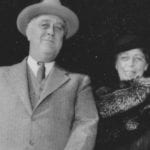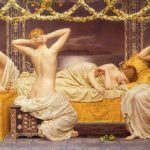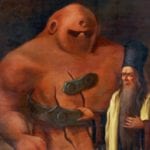 Creepy
Creepy  Creepy
Creepy  Technology
Technology 10 Scientific Breakthroughs of 2025 That’ll Change Everything
 Our World
Our World 10 Ways Icelandic Culture Makes Other Countries Look Boring
 Misconceptions
Misconceptions 10 Common Misconceptions About the Victorian Era
 Mysteries
Mysteries 10 Strange Unexplained Mysteries of 2025
 Miscellaneous
Miscellaneous 10 of History’s Most Bell-Ringing Finishing Moves
 History
History 10 Great Escapes That Ended Right Back in Captivity
 Weird Stuff
Weird Stuff 10 Fascinating Things You Might Not Know About Spiders
 Food
Food 10 Everyday Foods You Didn’t Know Were Invented by the U.S. Military
 History
History 10 Odd Things Colonial Americans Kept at Home
 Creepy
Creepy 10 More Representations of Death from Myth, Legend, and Folktale
 Technology
Technology 10 Scientific Breakthroughs of 2025 That’ll Change Everything
 Our World
Our World 10 Ways Icelandic Culture Makes Other Countries Look Boring
Who's Behind Listverse?

Jamie Frater
Head Editor
Jamie founded Listverse due to an insatiable desire to share fascinating, obscure, and bizarre facts. He has been a guest speaker on numerous national radio and television stations and is a five time published author.
More About Us Misconceptions
Misconceptions 10 Common Misconceptions About the Victorian Era
 Mysteries
Mysteries 10 Strange Unexplained Mysteries of 2025
 Miscellaneous
Miscellaneous 10 of History’s Most Bell-Ringing Finishing Moves
 History
History 10 Great Escapes That Ended Right Back in Captivity
 Weird Stuff
Weird Stuff 10 Fascinating Things You Might Not Know About Spiders
 Food
Food 10 Everyday Foods You Didn’t Know Were Invented by the U.S. Military
 History
History 10 Odd Things Colonial Americans Kept at Home
10 Intriguing Same-Sex Relationships From History
For much of history, homosexuality has been hidden away—if not in closets then in the privacy of people’s homes. Because of social stigma or cruel punishment, people were unable to live their lives openly. Yet history is littered with people who have formed strong same-sex relationships, whether sexual or not. It may be that some of these couples simply shared a friendship of such intensity that we today find it impossible to imagine it not being sexual.
10Marcela Gracia Ibeas & Elisa Sanchez Loriga

It is said that in 1061 two men were married by a priest in a small chapel in Spain. Little is known about the two men, Pedro Diaz and Muno Vandilaz, but a gay wedding, also in Spain, in 1901 is far better documented.
Marcela Gracia Ibeas and Elisa Sanchez Loriga met while training to be teachers. Their friendship was intense enough to cause concern as Marcela’s parents sent her away to complete her studies and to separate the pair. After their training, however, they were placed in neighboring rural parishes. Here, they began to live together.
Elisa took to presenting herself as a man and using the identity of a dead cousin, calling herself Mario. It was in this guise that the pair married on June 8, 1901. The secret of their marriage did not remain secret for long. The revelation that a same-sex couple had married was reported widely. They were sacked, excommunicated, and arrest warrants put out for the pair. They fled, first to Portugal and then to Argentina. In Argentina, Elisa, under a false name, married a man to set up a home where Marcela could live with her. This marriage was never consummated, and the husband discovered the pair’s identity.
In 1909, the press announced Elisa’s suicide. What happened to Marcela is not known. Their marriage to each other was never officially annulled.
9James I & George Villiers

When Queen Elizabeth died without an heir in 1603, the English crown passed to her relative James, King of Scotland. Since Elizabeth had been such a strong ruler, people joked that after the reign of King Elizabeth, it was now the reign of Queen James.
James seems to have had several favorite male courtiers throughout his life. When he was young, it was with the Earl of Lennox, who one observer reported “the Duke of Lennox went about to draw the King to carnal lust.” Others followed, but it was with George Villiers that James would make the most lasting relationship. As James openly told his Privy Council:
“You may be sure that I love the Earl of Buckingham [James made Villiers Earl of Buckingham] more than anyone else, and more than you who are here assembled. I wish to speak in my own behalf and not to have it thought to be a defect, for Jesus Christ did the same, and therefore I cannot be blamed. Christ had John, and I have George.”
Their relationship was certainly profitable to Villiers, who gained power, lands, titles, and wealth. It was not so to the realm. He mismanaged many things and came to be hated. After James’s death, Villiers was stabbed to death. But it seems he made the king happy. As James wrote in a private letter:
“Praying God that I may have a joyful and comfortable meeting with you, and that we may make at this Christenmass a new marriage, ever to be kept thereafter; for God so love me, as I desire only to live in this world for your sake, and that I had rather live banished in any part of the earth with you, then live a sorrowful widow-life without you.”
8Pan Zhang & Wang Zhongxian

Wang Zhongxian was the ruler of Chu, a feudal state in modern China, sometime in the fourth or third century BC. Hearing of a beautiful young scholar called Pan Zhang, the ruler asked for copies of his writings. The two met and are said to have fallen immediately in love with each other.
The pair lived the rest of their lives together. They were described as being as close as husband and wife, sharing the same bed and blanket and “unbounded intimacy.” The two lovers died at the same time and were buried together on the Mount Luofu. Here, a tree was planted on their grave. As it grew, the branches and twigs came to join and merge together, which people saw as an embrace. Seeing this as a representation of Pan Zhang and Wang Zhongxian’s love, the locals called this the “Shared Pillow Tree.”
7James Buchanan & William Rufus King

When future president James Buchanan was a young man, he became engaged to the rich and attractive Anne Coleman. She broke off the engagement, and Buchanan never did marry. He did, however, enter into a relationship with Senator William Rufus King.
The two politicians shared a home in Washington for 10 years. For two bachelors, this may seem to be just a money-saving act of prudence. However, the two were closer than simple housemates. President Jackson colorfully referred to them as “Miss Nancy” and “Aunt Fancy.”
When the two were separated because King went to France to serve as the United States ambassador, Buchanan wrote to a friend:
“I am now ‘solitary and alone,’ having no companion in the house with me. I have gone a wooing to several gentlemen, but have not succeeded with any one of them . . . [I] should not be astonished to find myself married to some old maid who can nurse me when I am sick, provide good dinners for me when I am well, and not expect from me any very ardent or romantic affection.”
6Queen Anne & Sarah Churchill

Queen Anne was never supposed to be a queen. She was the younger daughter of a king who had two sons. However, the crown did fall to her, and when she came to the throne, she brought with her the great friend of her youth, Sarah Churchill.
Sarah and Anne had served together as ladies in waiting to the old Queen and developed the nicknames “Mrs Morley” (Anne) and “Mrs Freeman” (Sarah) for each other. Anne found Sarah was willing to speak bluntly to her and adored her frankness. Once Queen, she made Sarah’s husband a duke, and Sarah herself received several positions at court.
However, Sarah overstepped her mark. Queen Anne found her frankness irritating now. Sarah once told the Queen in public to “be quiet.” Things worsened when Sarah found that Anne was spending long periods alone with a younger woman—her own relative Abigail Masham. Soon, rumors abounded about the “Dark Deeds at Night” that the young Masham provided to the Queen. Sarah was fired from all her positions and left the country, only returning after Anne’s death.
5David & Jonathan

Oscar Wilde said, “‘The Love that dare not speak its name’ in this century is such a great affection of an elder for a younger man as there was between David and Jonathan . . . It is that deep, spiritual affection that is as pure as it is perfect.” He said this in a trial related to his alleged homosexuality. Is there any evidence in the Bible of a same-sex relationship between King David and Jonathan?
After David has slain Goliath, he takes the head to King Saul. When the king’s son Jonathan meets David. the pair form a bond. 1 Samuel 18:1 says “Jonathan became one in spirit with David and he loved him as himself.” The two exchange clothes and weapons and make a ‘covenant.’
King Saul becomes jealous of David. Jonathan helps David escape his father. As the two part, “David got up from the south side of the stone and bowed down before Jonathan three times, with his face to the ground. Then they kissed each other and wept together—but David wept the most.” Jonathan is later killed in battle and David grieves for him. “Your love for me was wonderful, more wonderful than that of women.”
4Emperor Ai Of Han
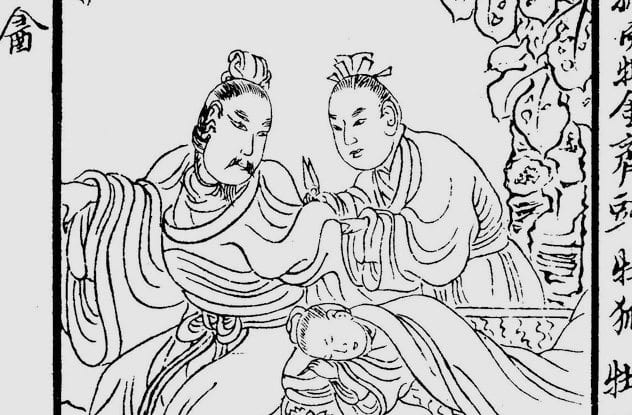
Emperor Ai ruled Han from 7–1 BC. Ai fell in love with a young retainer, Dong Xian, at court and would bequeath one of the most charming stories and phrases to history. Unfortunately, Ai’s desire for Dong would be the ruin of his beloved.
It is said that as soon as they saw each other, the Emperor was smitten. He showered his favorite with ever more titles. When a stranger at a feast marveled at such a young man having such power, the Emperor claimed that Dong was a sage. Those close to the Emperor told him that the state was being ruined on account of Dong, but the Emperor would do nothing.
It is said that once Dong fell asleep on the Emperor’s arm, not wanting to disturb his lover, the Emperor cut his sleeve off. This led to the phrase “passion of the cut sleeve” as a euphemism for homosexuality in Chinese.
Perhaps unsurprisingly given his fondness for Dong, Ai died without having produced an heir. On his death bed, he left the state to Dong Xian. This proved fatal for Dong, as he was soon relieved of all offices and banned from the palace. He committed suicide soon afterward.
3The Ladies Of Llangollen
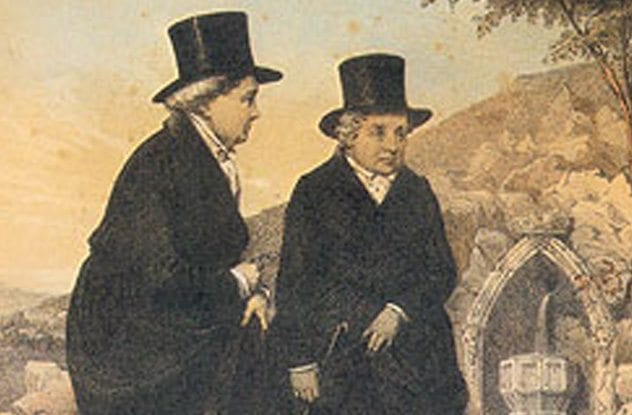
Eleanor Butler and Sarah Ponsonby came from the English aristocracy in Ireland. They met in 1768 and began a secret and intense correspondence. In 1778, the pair fled their families to avoid arranged marriages or being forced into a convent. The two ladies slept rough in barns in their attempt to reach a boat for England.
This attempt failed. They were discovered and taken to their separate homes and banned from seeing each other. Only their obstinacy prevented them being parted forever. When their families saw there was no alternative, Eleanor and Sarah were allowed to leave. They moved to Wales and set up a retreat in Llangollen. There, despite their efforts to be private, they soon became “the two most celebrated virgins in Europe.” All the great celebrities of the day either visited them or wrote to them.
For 50 years, the two lived contentedly in their splendid isolation, kept company by a loyal housekeeper and visitors. Today, their home is a museum.
2Hadrian & Antinous
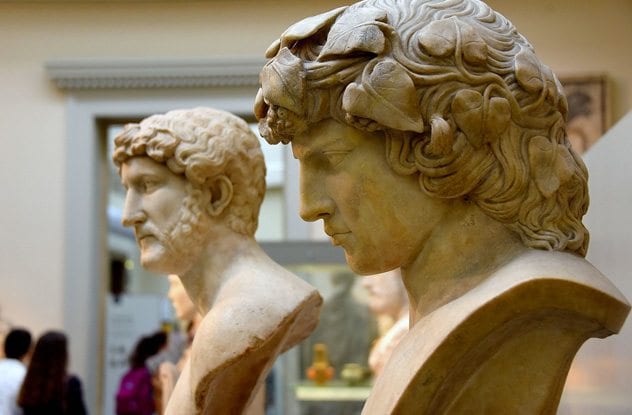
Homosexuality in the ancient world was not as universally approved of as some people would seem to believe. It was seen as unmanly for a male citizen to have too strong an infatuation with anyone, male or female, and disgraceful for a man to play the passive role in a homosexual relationship. Of course, rules are somewhat laxer when you are an emperor.
Hadrian discovered what many believe to have been the love of his life, Antinous, when the other was a boy. He took the handsome boy with him everywhere, leaving his wife at home. Hadrian was a restless administrator and traveled across the empire. It was while visiting Egypt that tragedy struck. Antinous mysteriously drowned in the Nile. Hadrian was beside himself with grief.
On the spot where he drowned, Hadrian constructed a new city, Antinopolis. He created a cult for the worship of the young man. Busts and statues of Antinous were raised throughout the empire. His face is one of the most recognizable from the ancient world, and copies of his image have been found from the corners of the empire.
1The Tyrannicides Of Athens
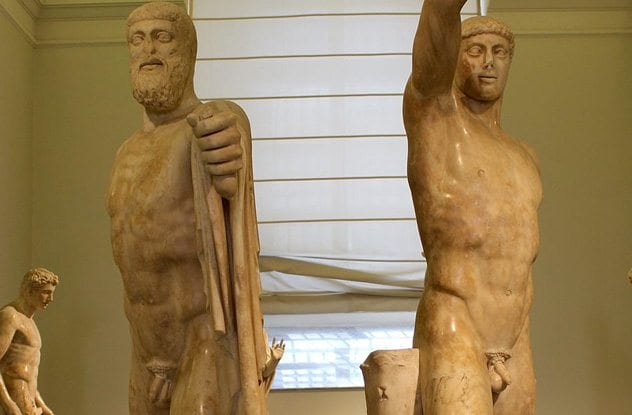
Upper-class Ancient Athenians tolerated a form of pedophilia that is shocking to us today. It was common for an older man to take a boy as his lover and introduce him into society. It was to be this practice which would give the Athenians their democracy, however.
Athens had tried democracy before but had fallen under the power of Hipparchus’s family. Hipparchus used his political position to try to force the pretty young boy Harmodius into being his lover. This upset not only the boy but his existing older lover Aristogeiton. The two lovers plotted together and at a religious sacrifice assassinated Hipparchus.
Hipparchus’s brother took sole control of the city and had the tyrannicides put to death. But when this last tyrant fell, Harmodius and Aristogeiton became symbols for Athens’s renewed democracy. A statue of the lovers was erected as a monument to freedom.
